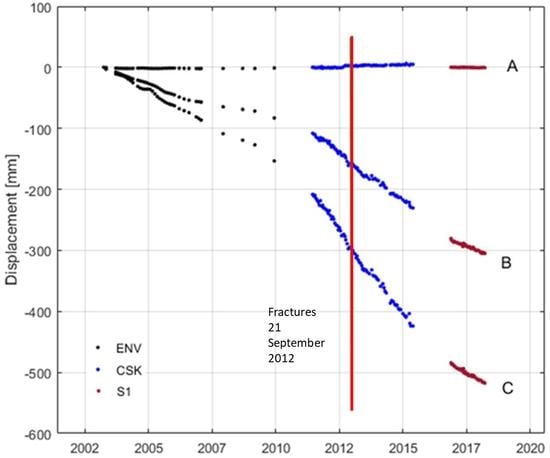Ground Deformations Controlled by Hidden Faults: Multi-Frequency and Multitemporal InSAR Techniques for Urban Hazard Monitoring
Abstract
1. Introduction
2. Geological Overview
3. Materials and Methods
3.1. Sentinel-1 SBAS Processing
3.2. Sentinel-1 PS Processing
4. Results
4.1. Comparison between SBAS and PS Processing
4.2. Deformation Time-Series Analysis
4.3. Vertical and East-West Components Estimation
5. Discussion
6. Conclusions
Author Contributions
Funding
Conflicts of Interest
References
- Brunori, C.A.; Bignami, C.; Stramondo, S.; Bustos, E. 20 years of active deformation on volcano caldera: Joint analysis of InSAR and AInSAR techniques. Int. J. Appl. Earth Obs. Geoinf. 2013. [Google Scholar] [CrossRef]
- Polcari, M.; Albano, M.; Atzori, S.; Bignami, C.; Stramondo, S. The Intraplate 2016 Mw 6.0 Australia Earthquake Studied by Insar Data. In Proceedings of the 2018 IEEE International Geoscience and Remote Sensing Symposium, Valencia, Spain, 22–27 July 2018; pp. 7283–7285. [Google Scholar]
- Chen, B.; Gong, H.; Lei, K.; Li, J.; Zhou, C.; Gao, M.; Guan, H.; Lv, W. Land subsidence lagging quantification in the main exploration aquifer layers in Beijing plain, China. Int. J. Appl. Earth Obs. Geoinf. 2019, 75, 54–67. [Google Scholar] [CrossRef]
- Cianflone, G.; Tolomei, C.; Brunori, C.A.; Monna, S.; Dominici, R. Landslides and subsidence assessment in the Crati Valley (Southern Italy) using insar data. Geosciences (Switzerland) 2018, 8, 67. [Google Scholar] [CrossRef]
- Cianflone, G.; Tolomei, C.; Brunori, C.A.; Dominici, R. InSAR Time Series Analysis of Natural and Anthropogenic Coastal Plain Subsidence: The Case of Sibari (Southern Italy). Remote Sens. 2015, 7, 16004–16023. [Google Scholar] [CrossRef]
- Strozzi, T.; Wegmüller, U.; Tosi, L.; Bitelli, G.; Spreckels, V. Land subsidence monitoring with differential SAR interferometry. Photogramm. Eng. Remote Sens. 2001, 67, 1261–1270. [Google Scholar]
- Cheloni, D.; De Novellis, V.; Albano, M.; Antonioli, A.; Anzidei, M.; Atzori, S.; Avallone, A.; Bignami, C.; Bonano, M.; Calcaterra, S.; et al. Geodetic model of the 2016 Central Italy earthquake sequence inferred from InSAR and GPS data. Geophys. Res. Lett. 2017, 44, 6778–6787. [Google Scholar] [CrossRef]
- Abelson, M.; Raz, E.; Magen, M.; Atzori, S.; Salvi, S.; Baer, G. SAR Interferometry for Sinkhole Early Warning and Susceptibility Assessment along the Dead Sea, Israel. Remote Sens. 2019, 1, 89. [Google Scholar] [CrossRef]
- Norini, G.; Capra, L.; Groppelli, G.; Agliardi, F.; Pola, A.; Cortes, A. Structural architecture of the Colima Volcanic Complex. J. Geophys. Res. 2010, 115, B12209. [Google Scholar] [CrossRef]
- Zobin, V.M.; Orozco-Rojas, J.; Reyes-Davila, G.A.; Navarro, C. Seismicity of an andesitic volcano during block-lava effusion: Volcan de Colima, Mexico. Bull. Volcanol. 2005, 67, 679–688. [Google Scholar] [CrossRef]
- Zobin, V.M.; Melnik, O.E.; González, M.; Macedo, O.; Bretón, M. Swarms of microearthquakes associated with the 2005 Vulcanian expLoSion sequence at Volcán de Colima. Geophys. J. Int. 2010, 182, 808–828. [Google Scholar] [CrossRef]
- Bouwer, H. Land subsidence and cracking due to ground-water depletion. Ground Water 1977, 15, 358–364. [Google Scholar] [CrossRef]
- Brunori, C.A.; Bignami, C.; Albano, M.; Zucca, F.; Samsonov, S.; Groppelli, G. Land subsidence, ground fissures and buried faults: InSAR monitoring of Ciudad Guzmán (Jalisco—Mexico). Remote Sens. 2015, 7, 8610–8630. [Google Scholar] [CrossRef]
- Bignami, C.; Brunori, C.A. The unfruitful monitoring of a tropical volcano using ENVISAT and COSMO-SkyMed time-series: Unexpected results. In Proceedings of the European Geosciences Union General Assembly 2018, Vienna, Austria, 8–13 April 2018. [Google Scholar]
- Bommer, J.J.; Rodríguez, C.E. Earthquake-induced landslides in Central America. Eng. Geol. 2002, 63, 189–220. [Google Scholar] [CrossRef]
- Ferrari, L.; Garduno, V.H.; Pasquarè, G.; Tibaldi, A. Volcanic and tectonic evolution of central Mexico: Oligocene to present. Geofis. Int. 1994, 33, 91–105. [Google Scholar]
- Ferrari, L.; Orozco-Esquivel, T.; Manea, V.; Manea, M. The dynamic history of the Trans-Mexican Volcanic Belt and the Mexico subduction zone. Tectonophysics 2012, 522, 122–149. [Google Scholar] [CrossRef]
- Latest Earthquakes. Available online: https://earthquake.usgs.gov/earthquakes/map/ (accessed on 10 December 2018).
- Gutierrez-Martinez, C.A.; Franco-Sànchez, M. Análisis de “Efecto de Sitio” en Ciudad Guzmán, Jalisco, México. Available online: http://www.funvisis.gob.ve/old/archivos/www/terremoto/Papers/Doc001/doc001.htm (accessed on 20 May 2019).
- Ferretti, A.; Prati, C.; Rocca, F. Permanent scatterers in SAR interferometry. IEEE Trans. Geosci. Remote Sens. 2001, 39, 8–20. [Google Scholar] [CrossRef]
- Ferretti, A.; Novali, F.; Bürgmann, R.; Hilley, G.; Prati, C. InSAR permanent scatterer analysis reveals ups and downs in San Francisco Bay Area. Eos Trans. AGU 2004, 85, 317–324. [Google Scholar] [CrossRef]
- Crosetto, M.; Monserrat, O.; Cuevas-González, M.; Devanthéry, N.; Crippa, B. Persistent Scatterer Interferometry: A review. ISPRS J. Photogramm. Remote Sens. 2016, 115, 78–89. [Google Scholar] [CrossRef]
- Berardino, P.; Fornaro, G.; Lanari, R.; Sansosti, E. A new algorithm for surface deformation monitoring based on small baseline differential sar interferograms. IEEE Trans. Geosci. Remote Sens. 2002, 40, 2375–2383. [Google Scholar] [CrossRef]
- Sansosti, E.; Casu, F.; Manzo, M.; Lanari, R. Spaceborne radar interferometry techniques for the generation of deformation time series: An advanced tool for Earth’s surface displacement analysis. Geophys. Res. Lett. 2010, 37. [Google Scholar] [CrossRef]
- Lauknes, T.R.; Dehls, J.; Larsen, Y.; Høgda, K.A.; Weydahl, D.J. A Comparison of SBAS and PS ERS InSAR for Subsidence Monitoring in Oslo, Norway. In Proceedings of the Fringe 2005 Workshop, Frascati, Italy, 28 November–2 December 2005; pp. 58–66. [Google Scholar]
- Bignami, C.; Brunori, C.A.; Murgia, F. Multi-sensor monitoring of Ciudad Guzmán (Mexico) ground subsidence. Procedia Comput. Sci. 2018, 138, 362–365. [Google Scholar] [CrossRef]
- Werner, C.; Wegmüller, U.; Strozzi, T.; Wiesmann, A. Interferometric Point Target Analysis for deformation mapping. In Proceedings of the 2003 IEEE Geoscience and Remote Sensing Symposium (IGARSS), Melbourne, Australia, 21–25 July 2003. [Google Scholar]
- PS Tutorial. Available online: http://www.sarmap.ch/tutorials/PS_Tutorial_V_0_9.pdf (accessed on 11 July 2019).
- Goldstein, R.M.; Werner, C.L. Radar interferogram filtering for geophysical applications. Geophys. Res. Lett. 1998, 25, 4035–4038. [Google Scholar] [CrossRef]
- Zhao, Q.; Ma, G.; Wang, Q.; Yang, T.; Liu, M.; Gao, W.; Falabella, F.; Mastro, P.; Pepe, A. Generation of long-term InSAR ground displacement time-series through a novel multi-sensor data merging technique: The case study of the Shanghai coastal area. ISPRS J. Photogramm. Remote Sens. 2019, 154, 10–27. [Google Scholar] [CrossRef]
- Estadísticas del Agua en México. Edición 2013–2018 Conagua-Comisión Nacional del Agua, Annual Report. Available online: http://sina.conagua.gob.mx/sina/index.php?publicaciones=1 (accessed on 7 February 2019).
- ACUERDO. Available online: https://www.ceajalisco.gob.mx/img/cuencas/acuerdo.pdf (accessed on 1 March 2019).
- Dalla Via, G.; Crosetto, M.; Crippa, B. Resolving vertical and east-west horizontal motion from differential interferometric synthetic aperture radar: The L’Aquila earthquake: Resolving z and e-w motion from D-InSAR. J. Geophys. Res. Solid Earth 2012, 117. [Google Scholar] [CrossRef]
- INEGI. Available online: https://www.inegi.org.mx/datos (accessed on 13 February 2019).
- Available online: http://www.ciudadGuzmán.gob.mx/Documentos/Paginas/DocEjec_POEL_ZapotlanelGrande_ver1.pdf (accessed on 18 February 2019).
- Available online: http://www.ciudadguzman.gob.mx/Documentos/General/pcivilGeneralPeligroGuzmanFoto.pdf (accessed on 12 March 2019).
- Zamudio-Zavala, P.; Andalón, M.; Mora, I. Atlas Municipal de Peligros y Riesgos Naturales del municipio de Zapotlán El Grande (Cd. Guzmán), Jalisco, 2016. Available online: https://fuegolentoblog.files.wordpress.com/2016/07/atlas-de-peligros-y-riesgos-natuarales-zapotlc3a1n-2015-capitulo-iv-falla-pag-14.pdf (accessed on 7 February 2019).
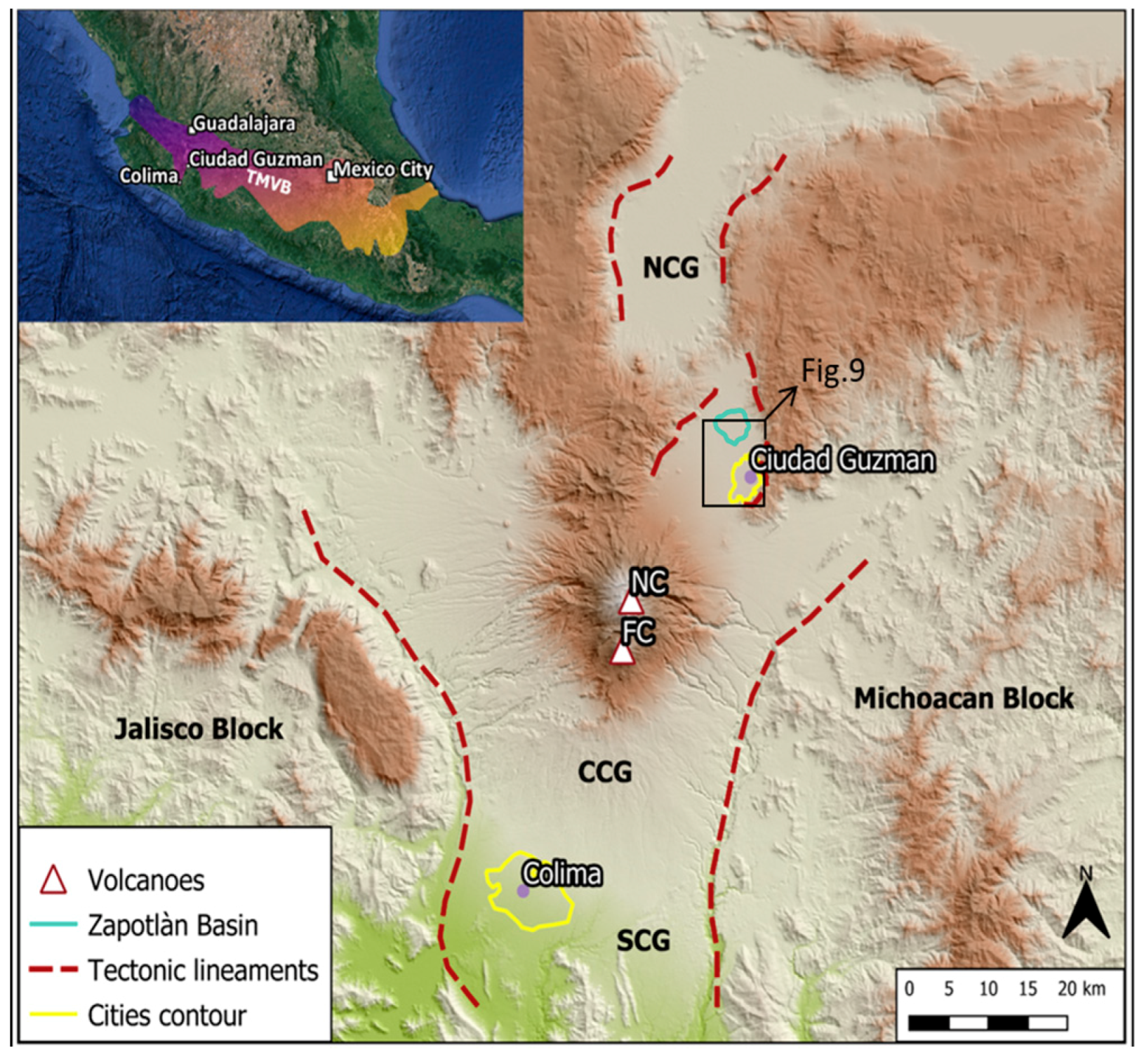
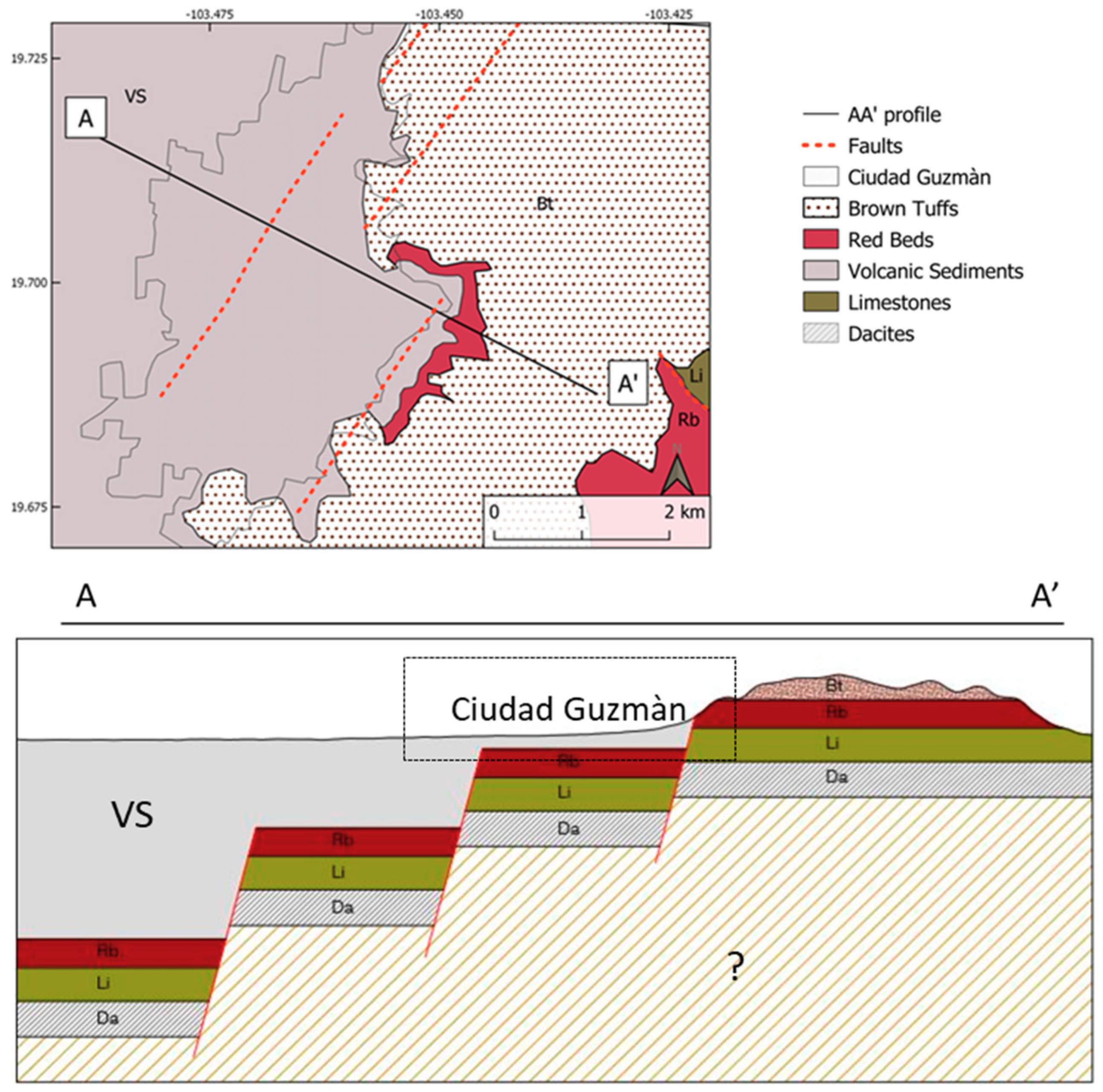
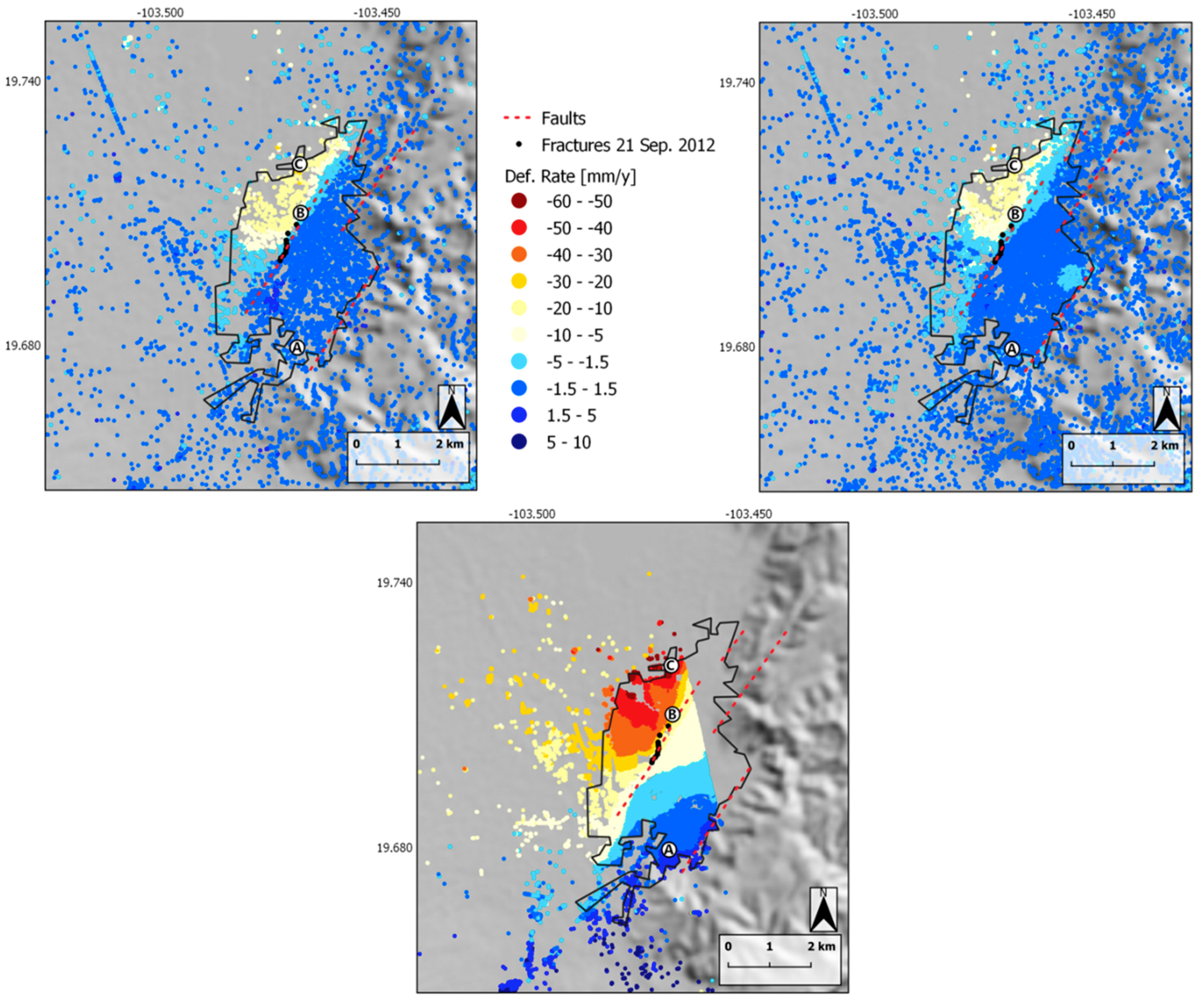
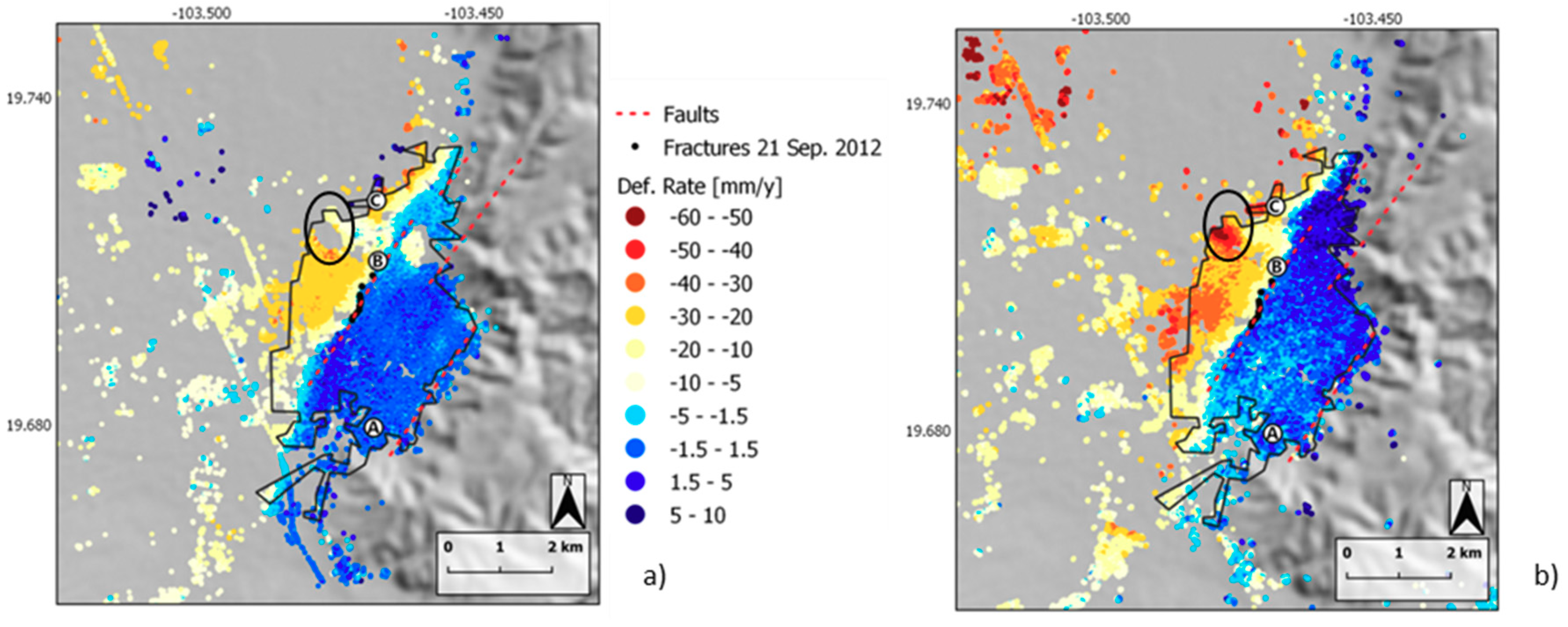
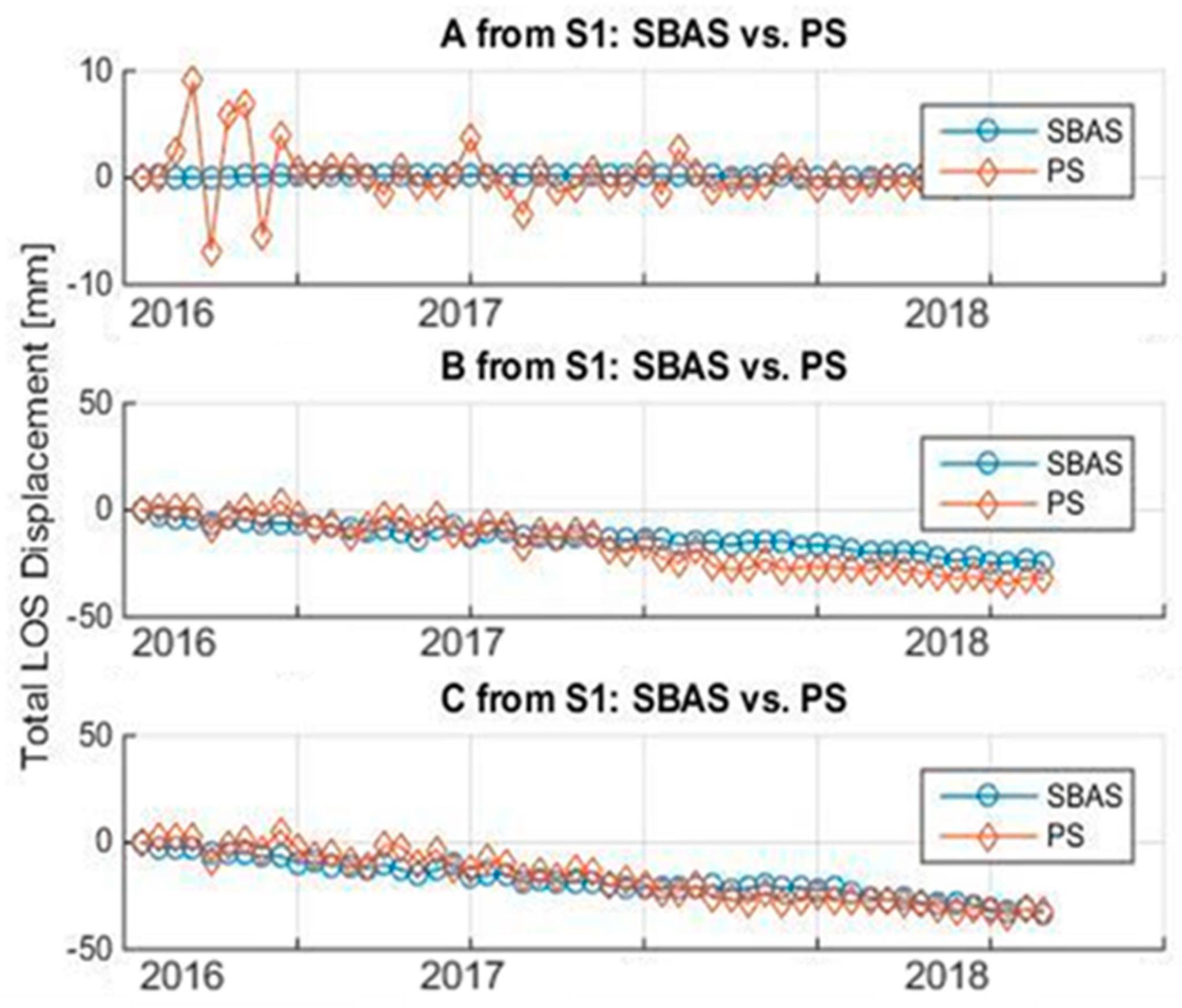

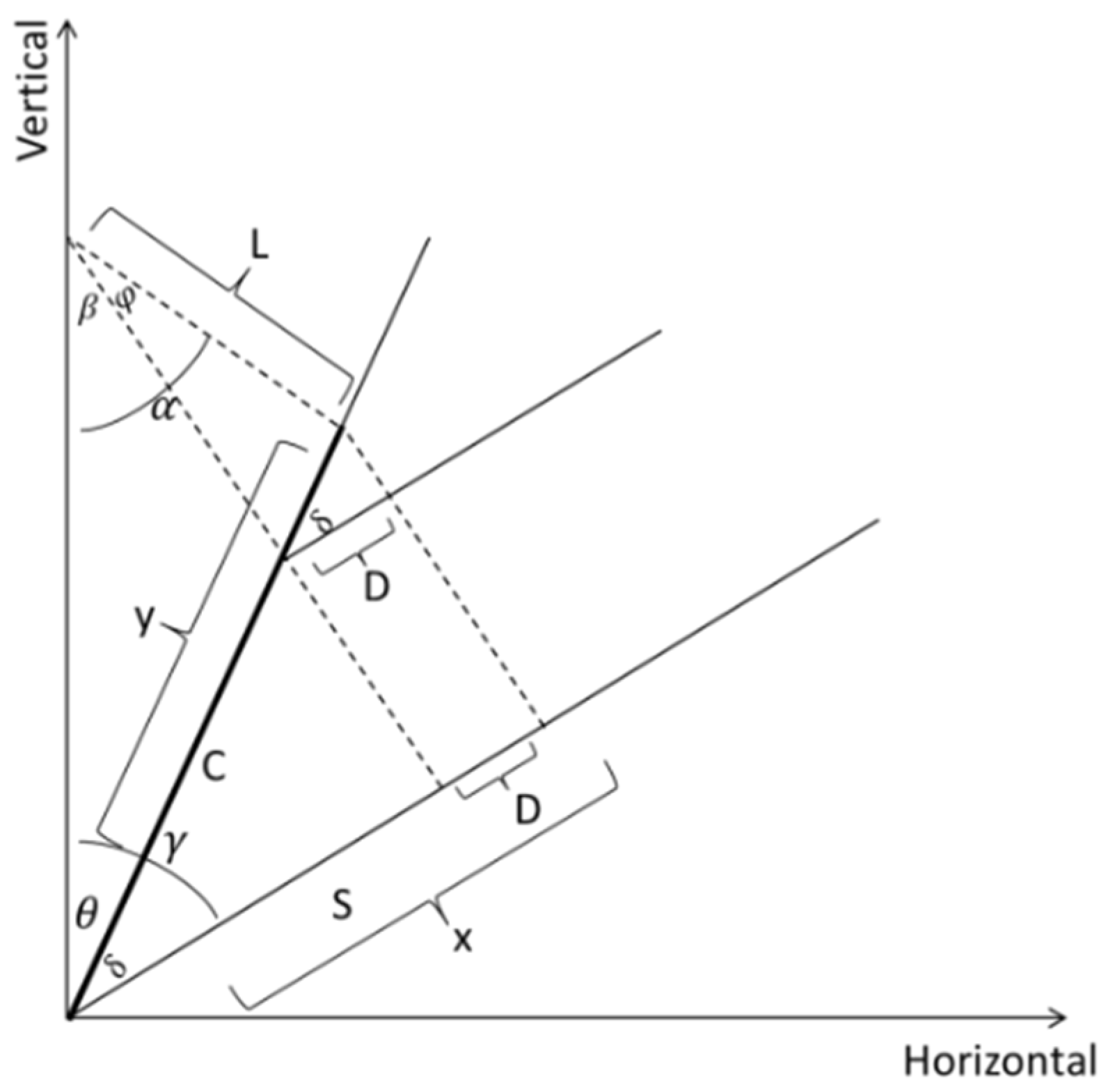
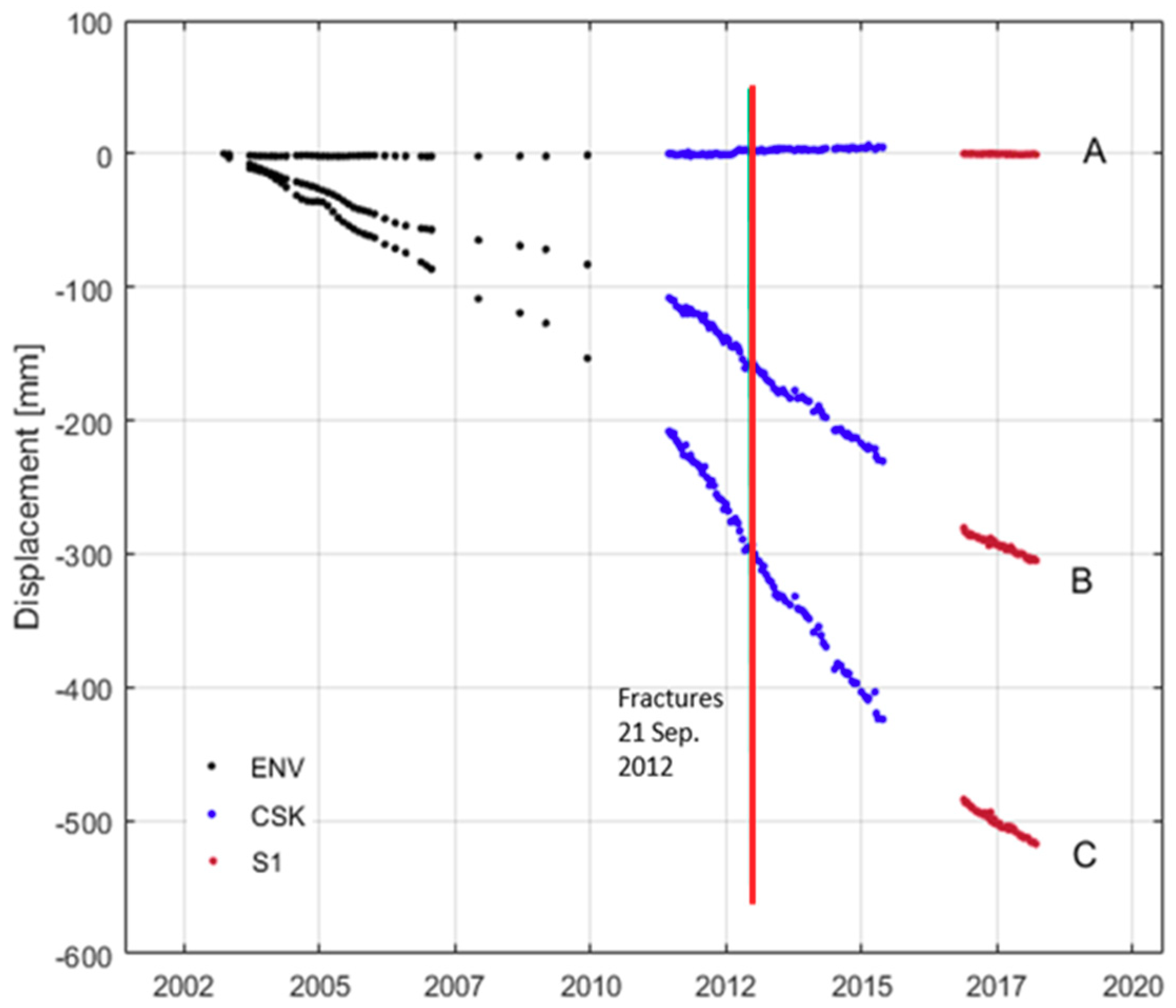
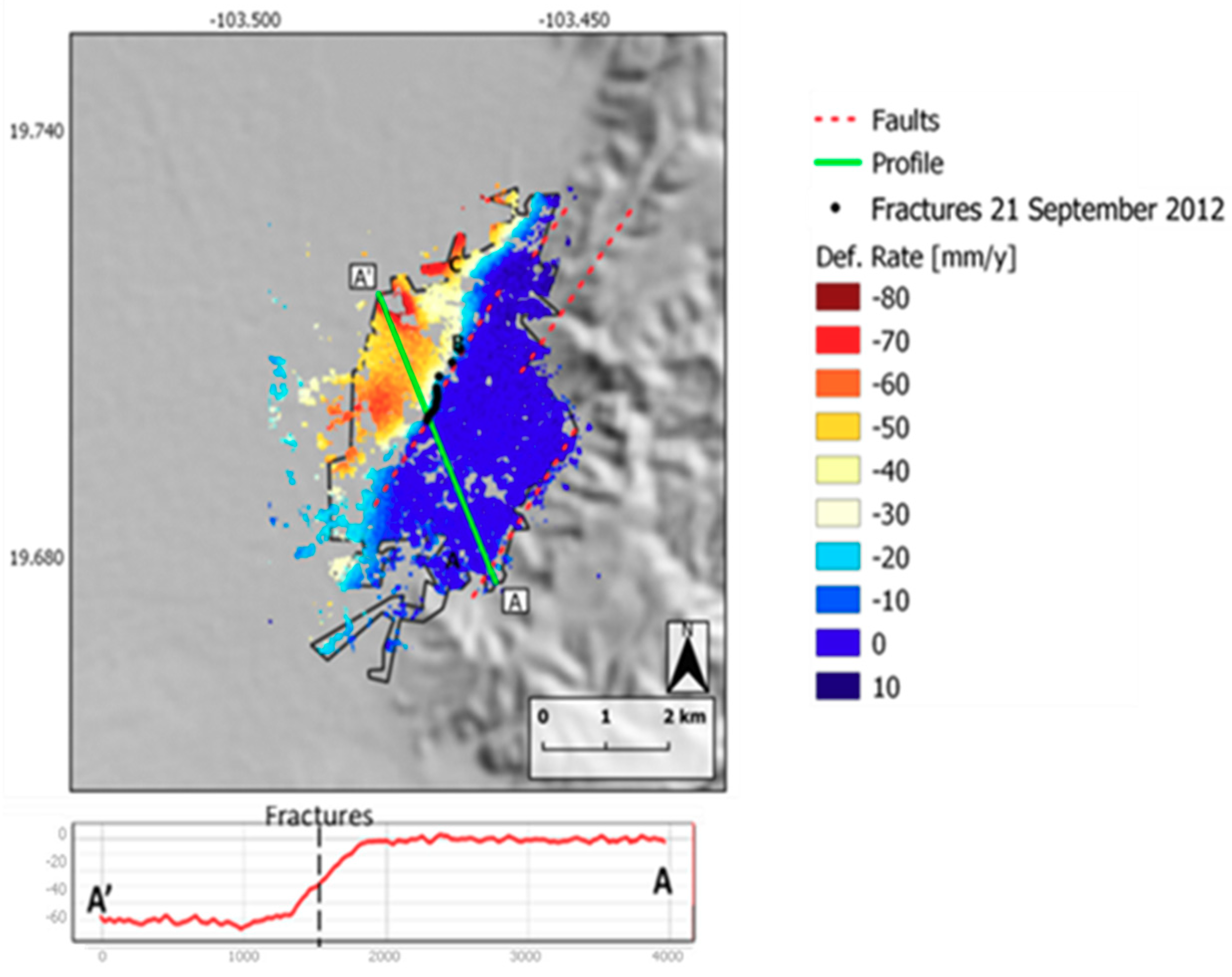
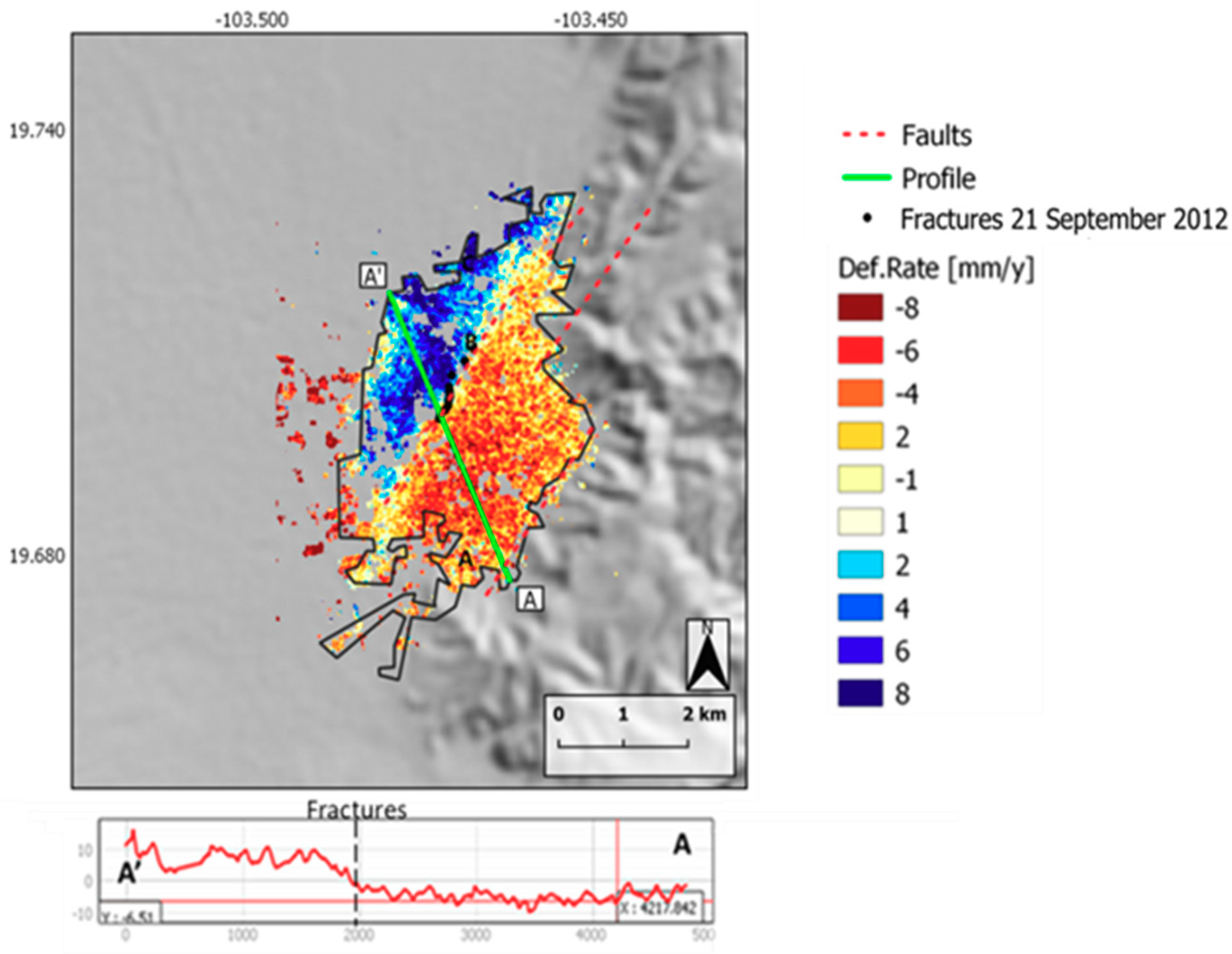
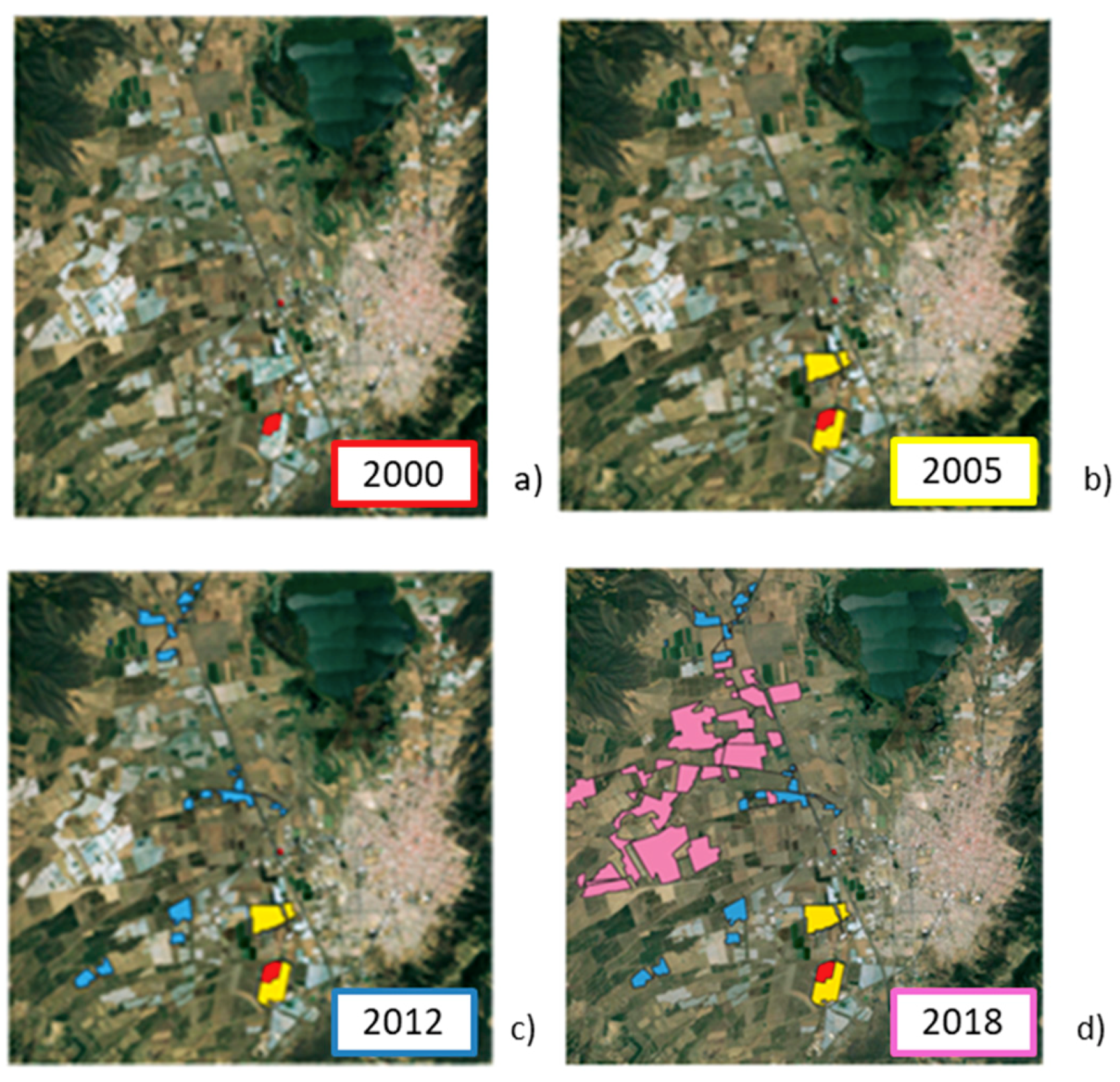
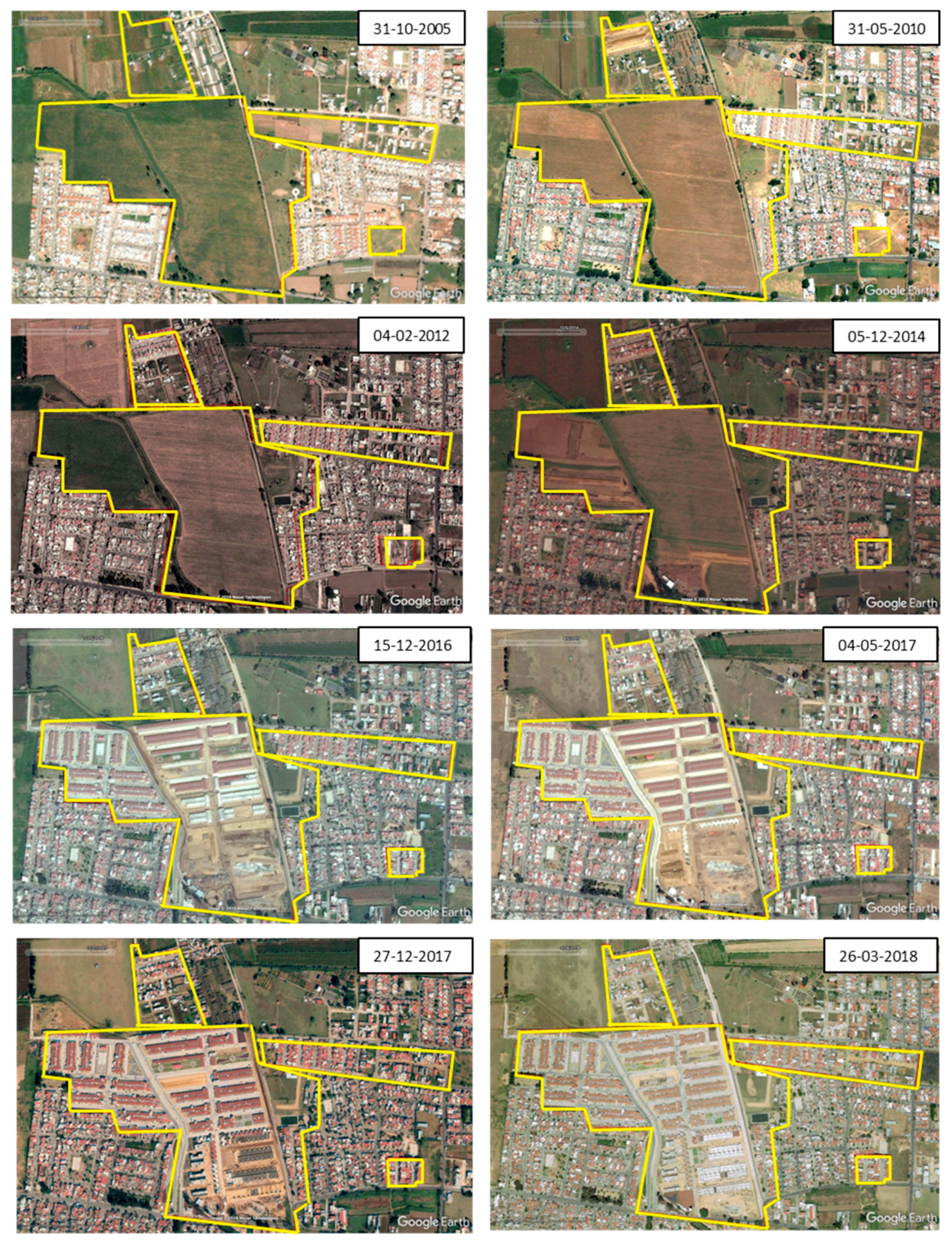
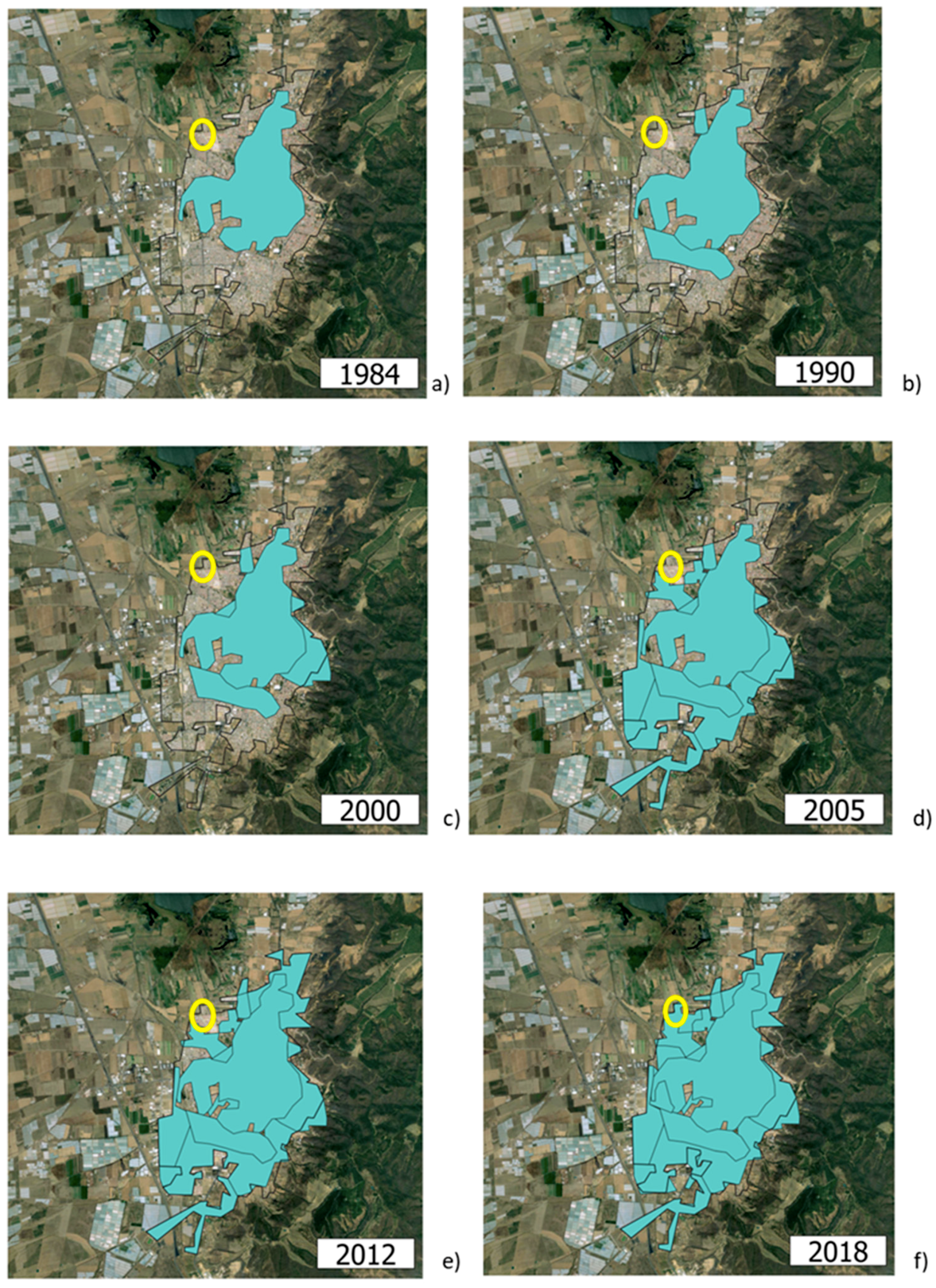
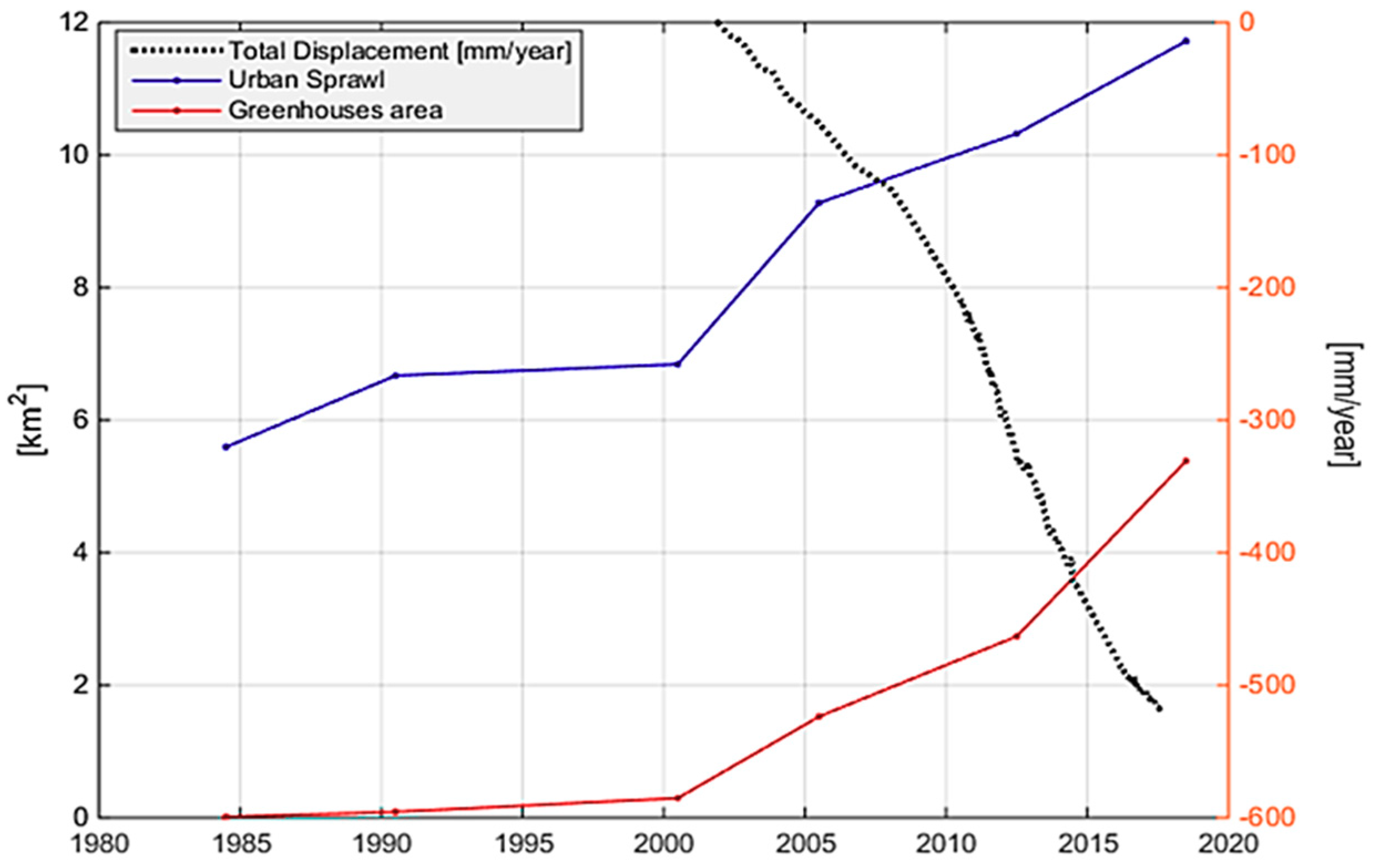
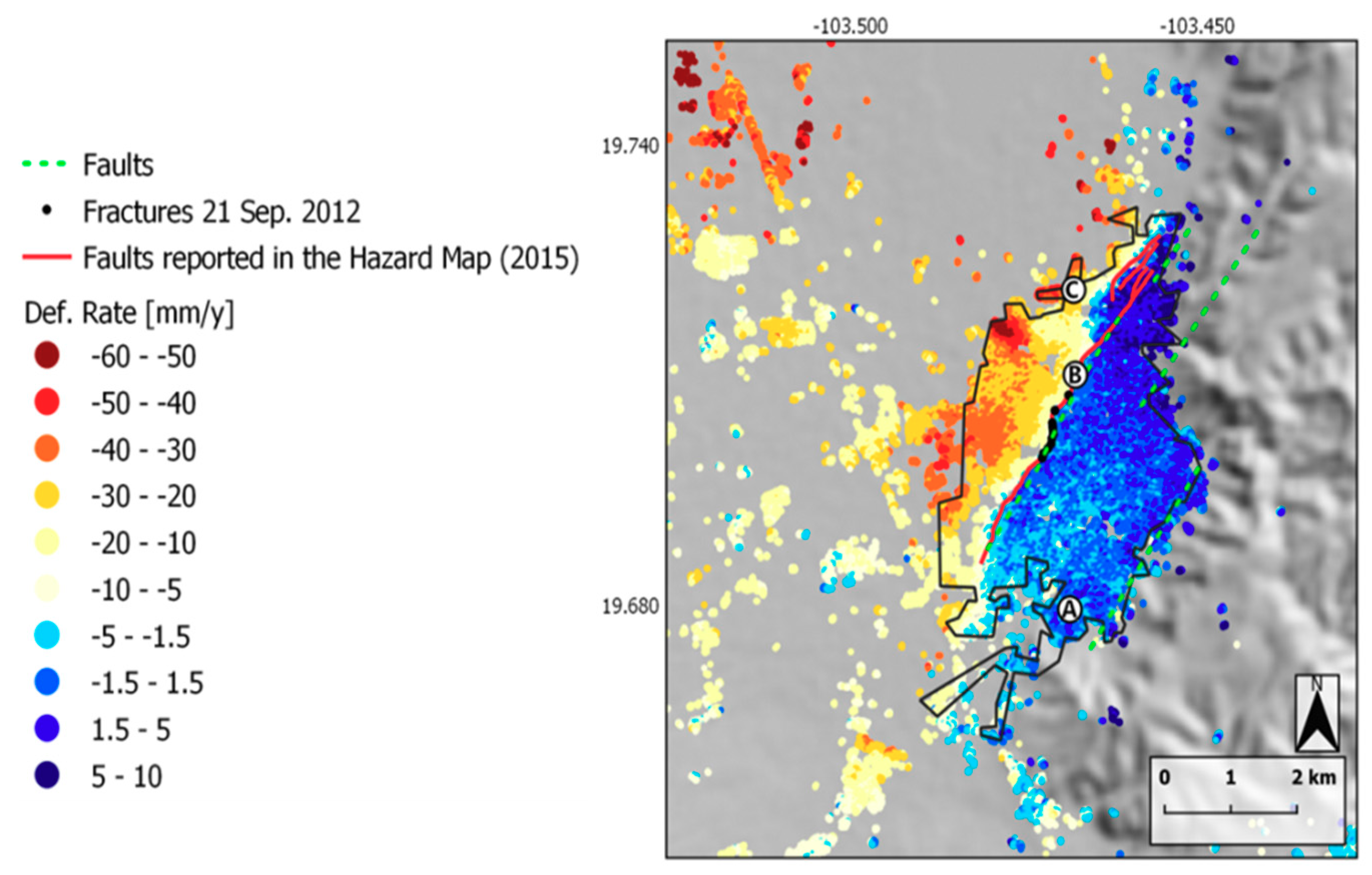
| # | Bias [mm/y] | Std Difference [mm/y] | Correlation |
|---|---|---|---|
| A | 0.832 | 0.731 | 0.767 |
| B | 2.903 | 2.794 | 0.975 |
| C | 8.866 | 2.587 | 0.957 |
© 2019 by the authors. Licensee MDPI, Basel, Switzerland. This article is an open access article distributed under the terms and conditions of the Creative Commons Attribution (CC BY) license (http://creativecommons.org/licenses/by/4.0/).
Share and Cite
Murgia, F.; Bignami, C.; Brunori, C.A.; Tolomei, C.; Pizzimenti, L. Ground Deformations Controlled by Hidden Faults: Multi-Frequency and Multitemporal InSAR Techniques for Urban Hazard Monitoring. Remote Sens. 2019, 11, 2246. https://doi.org/10.3390/rs11192246
Murgia F, Bignami C, Brunori CA, Tolomei C, Pizzimenti L. Ground Deformations Controlled by Hidden Faults: Multi-Frequency and Multitemporal InSAR Techniques for Urban Hazard Monitoring. Remote Sensing. 2019; 11(19):2246. https://doi.org/10.3390/rs11192246
Chicago/Turabian StyleMurgia, Federica, Christian Bignami, Carlo Alberto Brunori, Cristiano Tolomei, and Luca Pizzimenti. 2019. "Ground Deformations Controlled by Hidden Faults: Multi-Frequency and Multitemporal InSAR Techniques for Urban Hazard Monitoring" Remote Sensing 11, no. 19: 2246. https://doi.org/10.3390/rs11192246
APA StyleMurgia, F., Bignami, C., Brunori, C. A., Tolomei, C., & Pizzimenti, L. (2019). Ground Deformations Controlled by Hidden Faults: Multi-Frequency and Multitemporal InSAR Techniques for Urban Hazard Monitoring. Remote Sensing, 11(19), 2246. https://doi.org/10.3390/rs11192246





